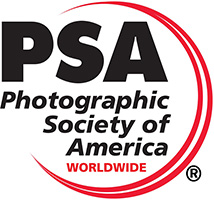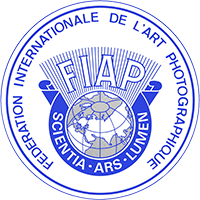


FIAP DEFINITIONS
MONOCHROME PHOTOGRAPHY
A black and white work fitting from the very dark grey (black) to the very clear grey (white) is a monochrome work with the various shades of grey. A black and white work toned entirely in a single colour will remain a monochrome work able to stand in the black and white category; such a work can be reproduced in black and white in the catalogue of a salon under FIAP Patronage. On the other hand a black and white work modified by a partial toning or by the addition of one colour becomes a colour work (polychrome) to stand in the colour category; such a work requires colour reproduction in the catalogue of a salon under FIAP Patronage.
FIAP and PSA NATURE PHOTOGRAPHY DEFINITION
Nature photography records all branches of natural history except anthropology and archaeology. This includes all aspects of the physical world, both animate and inanimate, that have not been made or modified by humans. Nature images must convey the truth of the scene that was photographed. A well-informed person should be able to identify the subject of the image and be satisfied that it has been presented honestly and that no unethical practices have been used to control the subject or capture the image. Images that directly or indirectly show any human activity that threatens the life or welfare of a living organism are not allowed.
The most important part of a Nature image is the nature story it tells. High technical standards are expected and the image must look natural. Adding a vignette or blurring the background during processing is not allowed. Objects created by humans, and evidence of human activity, are allowed in Nature images only when they are a necessary part of the Nature story.
Photographs of human-created hybrid plants, cultivated plants, feral animals, domesticated animals, human-created hybrid animals and mounted or preserved zoological specimens are not allowed.
Images taken with subjects under controlled conditions, such as zoos, are allowed.
Controlling live subjects by chilling, an aesthetic or any other method of restricting natural movement for the purpose of a photograph is not allowed.
No modification that changes the truth of a Nature image is allowed. Images may be cropped but no other technique that removes, adds or moves any part of the image is allowed. Techniques that remove elements added by the camera, such as dust spots, digital noise and lens flare are allowed. Complete conversion of color images to grayscale monochrome is allowed. Partial conversion, toning and infrared captures or conversions are not allowed.
Images of the same subject that are combined in-camera or with software by focus stacking or exposure blending are allowed. Multiple images with overlapping fields of view that are taken consecutively and combined in-camera or with software (image stitching) are allowed.
For the purpose of this exhibition any border added to a Nature digital file must be a single border of white or grey, no greater than 3 -5 pixels in width.
PEOPLE DEFINITION
Show us people in all situations, such as daily life, street photography, traditions, portrait, people at work, social events, human relations and etc. The main subject in the photo must be one or more human.
PSA DEFINITIONS
GENERAL
Entries must originate as photographs (image-capture of objects via light sensitivity) made by the entrant on photographic emulsion or acquired digitally. By virtue of submitting an entry, the entrant certifies the work as his/her own and permits the sponsors to reproduce all or part of the entered material free of charge for publication and / or display in media related to the exhibition. This may include low resolution posting on a website. The exhibition assumes no liability for any misuse of copyright. Images may be altered, either electronically or otherwise, by the maker and artwork or computer graphics created by the entrant may be incorporated if the photographic content predominates. A Social Documentary: is defined as an apposite comment on everyday social life or the environment.
MONOCHROME PHOTOGRAPHY
An image is considered to be Monochrome only if it gives the impression of having no color (i.e. contains only shades of gray which can include pure black and pure white) OR it gives the impression of being a grayscale image that has been toned in one color across the entire image. (For example by Sepia, red, gold, etc.) A grayscale or multi-colored image modified or giving the impression of having been modified by partial toning, multi toning or by the inclusion of spot coloring does not meet the definition of monochrome and shall be classified as a Color Work.
FIAP and PSA NATURE PHOTOGRAPHY DEFINITION
Nature photography records all branches of natural history except anthropology and archaeology. This includes all aspects of the physical world, both animate and inanimate, that have not been made or modified by humans. Nature images must convey the truth of the scene that was photographed. A well-informed person should be able to identify the subject of the image and be satisfied that it has been presented honestly and that no unethical practices have been used to control the subject or capture the image. Images that directly or indirectly show any human activity that threatens the life or welfare of a living organism are not allowed.
The most important part of a Nature image is the nature story it tells. High technical standards are expected and the image must look natural. Adding a vignette or blurring the background during processing is not allowed. Objects created by humans, and evidence of human activity, are allowed in Nature images only when they are a necessary part of the Nature story.
Photographs of human-created hybrid plants, cultivated plants, feral animals, domesticated animals, human-created hybrid animals and mounted or preserved zoological specimens are not allowed.
Images taken with subjects under controlled conditions, such as zoos, are allowed.
Controlling live subjects by chilling, an aesthetic or any other method of restricting natural movement for the purpose of a photograph is not allowed.
No modification that changes the truth of a Nature image is allowed. Images may be cropped but no other technique that removes, adds or moves any part of the image is allowed. Techniques that remove elements added by the camera, such as dust spots, digital noise and lens flare are allowed. Complete conversion of color images to grayscale monochrome is allowed. Partial conversion, toning and infrared captures or conversions are not allowed.
Images of the same subject that are combined in-camera or with software by focus stacking or exposure blending are allowed. Multiple images with overlapping fields of view that are taken consecutively and combined in-camera or with software (image stitching) are allowed.
For the purpose of this exhibition any border added to a Nature digital file must be a single border of white or grey, no greater than 3 -5 pixels in width.
PHOTO TRAVEL PHOTOGRAPHY
A Photo Travel image expresses the characteristic features or culture of a land as they are found naturally. There are no geographic limitations. Images from events or activities arranged specifically for photography, or of subjects directed or hired for photography are not appropriate. Close up pictures of people or objects must include features that provide information about the environment. Techniques that add, relocate, replace or remove any element of the original image, except by cropping, are not permitted. The only allowable adjustments are removal of dust or digital noise, restoration of the appearance of the original scene, and complete conversion to greyscale monochrome. Other derivations, including infrared, are not permitted. All images must appear natural.
CREATIVE PHOTOHRAPHY
The PSA definition of Creative is “Altered Reality.” The image must obviously display a change in natural color, form, shape, or any combination of these three. Creative images are often montages (a blending or composite of multiple images). High Dynamic Range (HDR) images without further changes are not considered “altered reality.” The original image must be made by the entrant on photographic emulsion or captured digitally. All images must be original and may not incorporate elements produced by anyone else. Original images must be altered by the maker; artwork or computer graphics generated by the entrant may be incorporated, if the original photographic content predominates. Images may not be constructed entirely within a computer. It is necessary that the image’s core content be identifiable. Non-creative images are not eligible for this competition. Any subject matter is acceptable as long as the Altered Reality guidelines are followed.
PHOTOJOURNALISM PHOTOGRAPHY
Photojournalism entries shall consist of images with informative content and emotional impact, including human interest, documentary, sports and spot news. The storytelling value of the image shall receive priority over pictorial quality. In the interest of credibility, PJ images must not misrepresent the truth. No situations shall be set up for the purpose of photography, and no alteration of the subject matter is allowed, including any techniques that add combine, relocate, replace or remove any elements of the original image. No unnatural sharpening or special effects filters can be applied. Only cropping, resizing, lightening, or darkening and restoration of original color are permitted. Color images can be converted to monochrome. “Human Interest is defined as an image depicting a person or persons in an interactive, emotional or unusual situation, excluding recreational and sports action.”
AERIAL PHOTOGRAPHY POLICIES (ethical)
One of the tenets of photography, is that the safety and well-being of the subject, photographer and surroundings is of para-mount importance over the capturing of the photograph. The purpose of this section is to prevent any interference with other individuals or animals which will or may cause a disturbance in their normal activity or disrupt the way an individual or animal interacts with its environment.
1. May not fly a drone above people for the purpose of photographing their activity, unless permission is granted in writing.
2. May not fly or photograph animals in their natural habitat, especially nesting areas and locations where the animal is already under stress (winter survival, migratory feeding, protecting young). Photographing scenery/landscapes is permissible.
3. May not fly or photograph in any designated wilderness area.